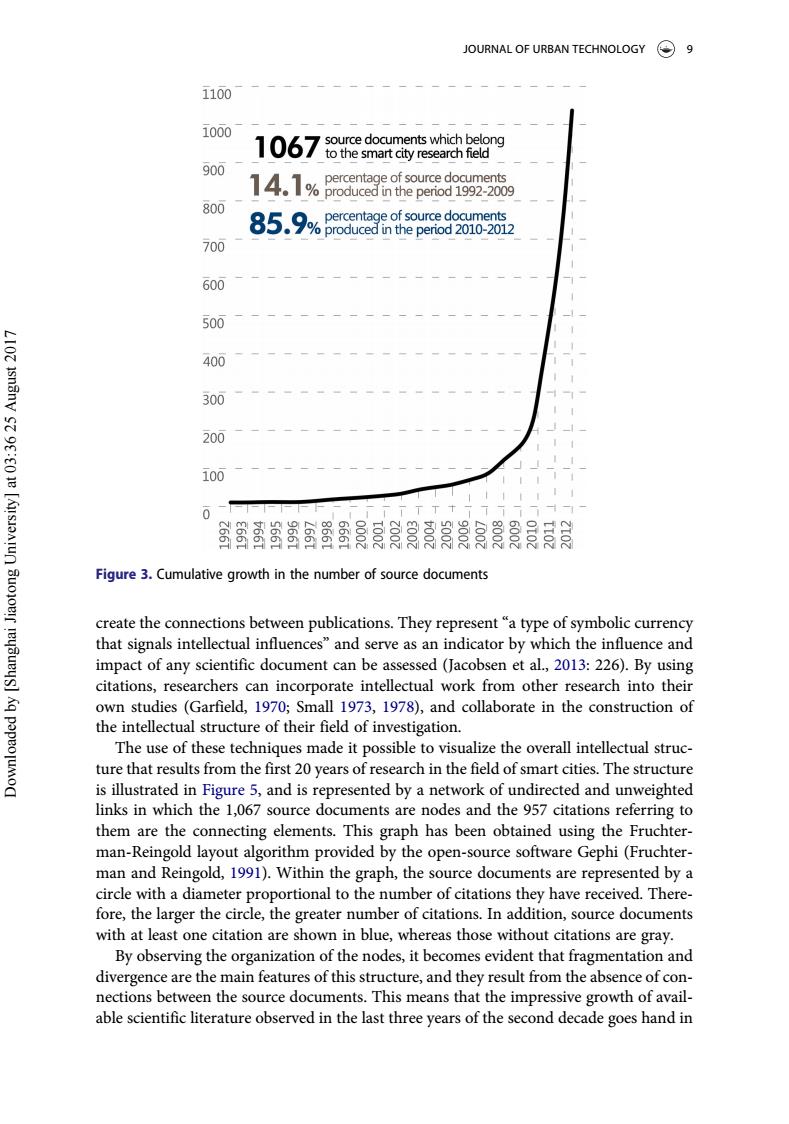正在加载图片...

JOURNAL OF URBAN TECHNOLOGY 9 1100 1000 1source documents which belong to the smart city research field 900 %produced un the period 19922009 percentage of source documents 800 5%produced in the perod 2010-2012 percentage of source documents 700 600 500 400 LIOZ isnanV st 96:E0 e [AlIsJaalun 300 200 100 0- TT 含昌香台驾含器器号是尾第葛美号爱司美 Figure 3.Cumulative growth in the number of source documents uoloef eyueyS] create the connections between publications.They represent"a type of symbolic currency that signals intellectual influences"and serve as an indicator by which the influence and impact of any scientific document can be assessed (Jacobsen et al.,2013:226).By using citations,researchers can incorporate intellectual work from other research into their own studies (Garfield,1970;Small 1973,1978),and collaborate in the construction of 花o P the intellectual structure of their field of investigation. The use of these techniques made it possible to visualize the overall intellectual struc- ture that results from the first 20 years of research in the field of smart cities.The structure is illustrated in Figure 5,and is represented by a network of undirected and unweighted links in which the 1,067 source documents are nodes and the 957 citations referring to them are the connecting elements.This graph has been obtained using the Fruchter- man-Reingold layout algorithm provided by the open-source software Gephi(Fruchter- man and Reingold,1991).Within the graph,the source documents are represented by a circle with a diameter proportional to the number of citations they have received.There- fore,the larger the circle,the greater number of citations.In addition,source documents with at least one citation are shown in blue,whereas those without citations are gray. By observing the organization of the nodes,it becomes evident that fragmentation and divergence are the main features of this structure,and they result from the absence of con- nections between the source documents.This means that the impressive growth of avail- able scientific literature observed in the last three years of the second decade goes hand increate the connections between publications. They represent “a type of symbolic currency that signals intellectual influences” and serve as an indicator by which the influence and impact of any scientific document can be assessed (Jacobsen et al., 2013: 226). By using citations, researchers can incorporate intellectual work from other research into their own studies (Garfield, 1970; Small 1973, 1978), and collaborate in the construction of the intellectual structure of their field of investigation. The use of these techniques made it possible to visualize the overall intellectual structure that results from the first 20 years of research in the field of smart cities. The structure is illustrated in Figure 5, and is represented by a network of undirected and unweighted links in which the 1,067 source documents are nodes and the 957 citations referring to them are the connecting elements. This graph has been obtained using the Fruchterman-Reingold layout algorithm provided by the open-source software Gephi (Fruchterman and Reingold, 1991). Within the graph, the source documents are represented by a circle with a diameter proportional to the number of citations they have received. Therefore, the larger the circle, the greater number of citations. In addition, source documents with at least one citation are shown in blue, whereas those without citations are gray. By observing the organization of the nodes, it becomes evident that fragmentation and divergence are the main features of this structure, and they result from the absence of connections between the source documents. This means that the impressive growth of available scientific literature observed in the last three years of the second decade goes hand in Figure 3. Cumulative growth in the number of source documents JOURNAL OF URBAN TECHNOLOGY 9 Downloaded by [Shanghai Jiaotong University] at 03:36 25 August 2017